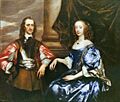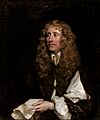Peter Lely facts for kids
Quick facts for kids
Peter Lely
|
|
|---|---|
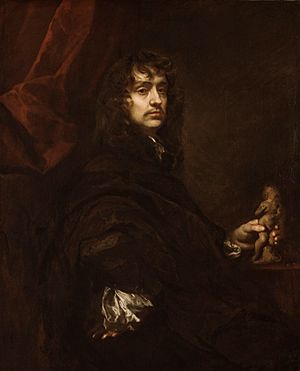
|
|
| Born |
Pieter van der Faes
14 September 1618 |
| Died | 7 December 1680 (aged 62) |
| Nationality | Dutch – English |
| Known for | Painting |
| Signature | |
 |
|
Sir Peter Lely (born September 14, 1618 – died December 7, 1680) was a famous painter. He was born in the Netherlands but spent almost his whole career in England. He became the most important portrait painter for the King's court. He even became a British citizen and was made a knight in 1679.
Contents
Peter Lely's Early Life
Lely was born as Pieter van der Faes. His parents were Dutch. He was born in Soest, a town in Westphalia. His father was an officer in the army there.
Lely studied painting in Haarlem, a city in the Netherlands. He might have learned from a painter named Pieter de Grebber. In 1637, he became a master in the Guild of Saint Luke in Haarlem. This was a special group for artists. People say he chose the name "Lely" because of a lily flower symbol. This symbol was on the house where his father was born in The Hague.
Moving to England
Lely came to London around 1643. His first paintings in England were often about myths or religious stories. Some showed people in peaceful outdoor scenes. These early works showed influences from other famous painters like Anthony van Dyck. They also showed the style of Dutch baroque art.
Lely's portraits became very popular. He took over from Anthony van Dyck, who had died in 1641. Lely became the most fashionable portrait artist in England. In 1647, he joined the Worshipful Company of Painter-Stainers. He became the portrait artist for King Charles I.
Even after King Charles I was executed, Lely's career continued. He painted for Oliver Cromwell, who ruled England for a time. He also painted for Oliver's son, Richard Cromwell. Around 1650, a poet named Sir Richard Lovelace wrote two poems about Lely's paintings.
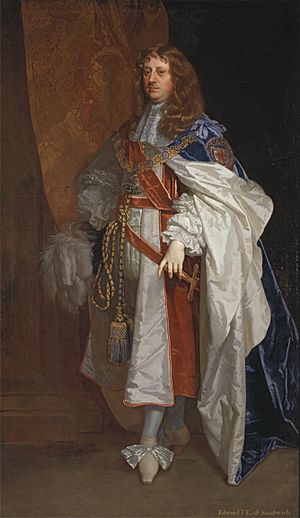
Royal Painter for King Charles II
In 1660, the monarchy was restored in England. Charles II became king. In 1661, Lely was named the King's Principal Painter in Ordinary. This was a very important job. He received £200 a year, just like Van Dyck had before him.
Lely became a naturalized English citizen in 1662. A young scientist named Robert Hooke even worked as an apprentice for Lely for a short time.
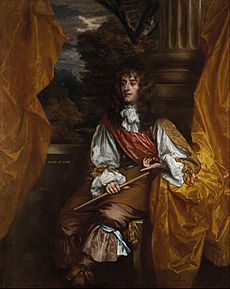
There was a huge demand for Lely's paintings. He and his large workshop produced many artworks. Lely would paint the person's head. Then, his students would often finish the rest of the portrait. They used a set of common poses. Because of this, Lely left behind a huge number of paintings. The quality of these paintings can vary. Some are amazing originals by Lely himself. Others were mostly done by his assistants.
Famous Works by Peter Lely
Some of Lely's most famous paintings include:
- A series of 10 portraits of ladies from the Royal court. These are called the Windsor Beauties. They are now at Hampton Court Palace.
- A similar series of paintings for Althorp house.
- A series of 12 portraits of admirals and captains. These men fought in the Second Anglo-Dutch War. This series is known as the "Flagmen of Lowestoft". Most are now owned by the National Maritime Museum.
- His painting called Susannah and the Elders at Burghley House.
His most famous painting that is not a portrait is probably Nymphs by a Fountain. This painting is in the Dulwich Picture Gallery.
Lely also helped bring a new printing technique to Britain. It was called mezzotint. He saw that this technique could help share his portraits with more people. He encouraged Dutch mezzotint artists to come to Britain. They copied his work, which started the English mezzotint tradition.
Lely lived in Covent Garden from about 1651 to 1680. He was made a knight in 1679. Sir Peter Lely died soon after, in 1680. He passed away at his easel while painting a portrait. He was buried at St Paul's Church, Covent Garden.
Peter Lely's Legacy
During his life, Lely was known for being a great art collector. He had a large collection of Old Master paintings. These included works by famous artists like Veronese, Titian, Claude Lorrain, and Rubens. He also had a wonderful collection of drawings. After he died, his collection was sold. It brought in a huge amount of money, £26,000. Some art pieces that Lely had bought from King Charles I's collection were bought back by the Royal Collection. One example is the Lely Venus.
After Lely, Sir Godfrey Kneller became the court portraitist. Kneller was also born in Germany and was Dutch. His style was similar to Lely's but also showed newer European art trends.
Images for kids
-
Catherine of Braganza, Queen of England 1665
-
Portrait of Charlotte Lee, Countess of Lichfield 1674
See also
 In Spanish: Peter Lely para niños
In Spanish: Peter Lely para niños



